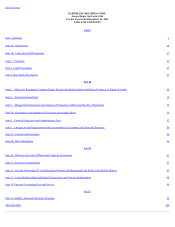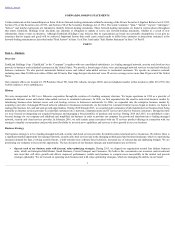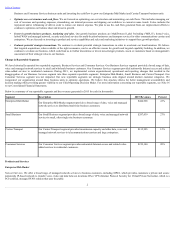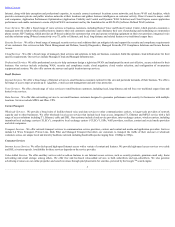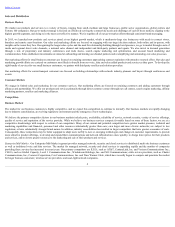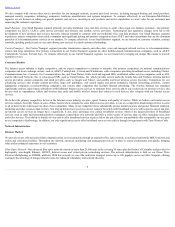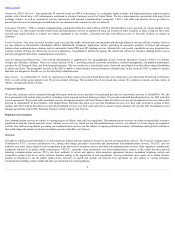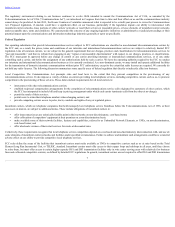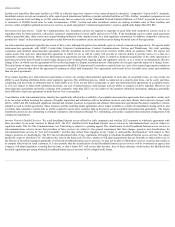Earthlink 2015 Annual Report Download - page 10
Download and view the complete annual report
Please find page 10 of the 2015 Earthlink annual report below. You can navigate through the pages in the report by either clicking on the pages listed below, or by using the keyword search tool below to find specific information within the annual report.
Table of Contents
The regulatory environment relating to our business continues to evolve. Bills intended to amend the Communications Act of 1934, as amended by the
Telecommunications Act of 1996 (“Communications Act”), are introduced in Congress from time to time and their effect on us and the communications industry
cannot always be predicted. In late 2013, the House Commerce Committee announced what is expected to be a multi-year process to revise the Communications
Act. Proposed legislation, if enacted, could have a significant effect on our business, particularly if the legislation impairs our ability to interconnect with
incumbent carrier networks, lease portions of other carriers' networks or resell their services at reasonable prices, or lease elements of incumbent carrier networks
under acceptable rates, terms and conditions. We cannot predict the outcome of any ongoing legislative initiatives or administrative or judicial proceedings or their
potential impact upon the communications and information technology industries generally or upon us specifically.
Federal Regulation
Our operating subsidiaries that provide telecommunications services subject to FCC authorizations are classified as non-dominant telecommunications carriers by
the FCC and, as a result, the prices, terms and conditions of our interstate and international telecommunications services are subject to relatively limited FCC
regulation. Like all common carriers, we are subject to the general requirement that our charges, practices and classifications for telecommunications services be
“just and reasonable,” and that we refrain from engaging in any “unjust or unreasonable discrimination” with respect to our charges, practices or classifications.
The FCC must grant its approval before any change in control of any carrier providing interstate or international communications services, or of any entity
controlling such a carrier, and before the assignment of any authorizations held by such a carrier. We have the operating authority required by the FCC to conduct
our interstate and international telecommunications business as it is currently conducted. As a non-dominant carrier, we may install and operate additional facilities
for the transmission of domestic interstate communications without prior FCC authorization, except to the extent that radio licenses are required. We currently do
not hold any radio licenses. The following discussion summarizes some specific areas of federal regulation that directly or indirectly affect our business.
Local Competition. The Communications Act preempts state and local laws to the extent that they prevent competition in the provisioning of any
telecommunications service. It also imposes a variety of duties on carriers providing local telephone services, including competitive carriers such as us, to promote
competition in the provisioning of these services. These duties include requirements for all local carriers to:
•interconnect with other telecommunications carriers;
• establish reciprocal compensation arrangements for the completion of telecommunications service calls originated by customers of other carriers, which
the FCC has interpreted to include bill and keep (a pricing arrangement under which each carrier terminates calls from the other at no charge);
• permit the resale of their services;
• permit users to retain their telephone numbers when changing carriers; and
• provide competing carriers access to poles, ducts, conduits and rights-of-way at regulated prices.
Incumbent carriers, which are telephone companies that held monopoly local telephone service franchises before the Telecommunications Act of 1996, or their
successors in interest, are subject to additional duties. These include obligations of incumbent carriers to:
• offer interconnection at any technically feasible point in their networks on non-discriminatory, cost-based terms;
• offer collocation of competitors' equipment at their premises on a non-discriminatory basis;
• make available some of their network facilities, features and capabilities, referred to as Unbundled Network Elements, or UNEs, on non-discriminatory,
cost-based terms; and
•offer wholesale versions of their retail services for resale at discounted rates.
Collectively, these requirements recognize that local telephone service competition depends on cost-based and non-discriminatory interconnection with, and use of,
some elements of incumbent carrier networks and facilities under specified circumstances. Failure to achieve and maintain such arrangements could have a material
adverse effect on our ability to provide competitive local telephone services.
FCC rules define the scope of the facilities that incumbent carriers must make available as UNEs to competitive carriers such as us at rates based on the Total
Element Long Run Incremental Cost, or TELRIC, standard. Incumbent carriers must offer access to their copper loops and subloops in all areas, until they choose
to retire them, but must offer access to certain higher-capacity DS1 and DS3 transmission facilities only in wire center serving areas with relatively few business
lines and collocated competitive carriers, as defined by detailed FCC regulations. In general, incumbent carriers are not required to offer DS1 and DS3 transmission
7



